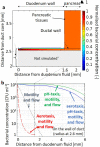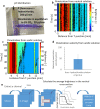pH-taxis drives aerobic bacteria in duodenum to migrate into the pancreas with tumors
- PMID: 35110595
- PMCID: PMC8810860
- DOI: 10.1038/s41598-022-05554-8
pH-taxis drives aerobic bacteria in duodenum to migrate into the pancreas with tumors
Abstract
As oral or intestinal bacteria have been found in pancreatic cystic fluid and tumors, understanding bacterial migration from the duodenum into the pancreas via hepato-pancreatic duct is critical. Mathematical models of migration of aerobic bacteria from the duodenum to the pancreas with tumors were developed. Additionally, the bacterial distributions under the pH gradient and those under flow were measured in double-layer flow based microfluidic device and T-shaped cylinders. Migration of aerobic bacteria from the duodenum into pancreas is counteracted by bile and pancreatic juice flow but facilitated by pH-taxis from acidic duodenum fluid toward more favorable slightly alkaline pH in pancreatic juice. Additionally, the reduced flow velocity in cancer patients, due to compressed pancreatic duct by solid tumor, facilitates migration. Moreover, measured distribution of GFP E. coli under the pH gradient in a microfluidic device validated pH-tactic behaviors. Furthermore, Pseudomonas fluorescens in hydrochloride solution, but not in bicarbonate solution, migrated upstream against bicarbonate flow of > 20 μm/s, with an advancement at approximately 50 μm/s.
© 2022. The Author(s).
Conflict of interest statement
The authors declare no competing interests.
Figures








Similar articles
-
The Microbiomes of Pancreatic and Duodenum Tissue Overlap and Are Highly Subject Specific but Differ between Pancreatic Cancer and Noncancer Subjects.Cancer Epidemiol Biomarkers Prev. 2019 Feb;28(2):370-383. doi: 10.1158/1055-9965.EPI-18-0542. Epub 2018 Oct 29. Cancer Epidemiol Biomarkers Prev. 2019. PMID: 30373903 Free PMC article.
-
Understanding bacterial infiltration of the pancreas through a deformable pancreatic duct.J Biomech. 2024 Jan;162:111883. doi: 10.1016/j.jbiomech.2023.111883. Epub 2023 Nov 29. J Biomech. 2024. PMID: 38064997
-
Helicobacter species ribosomal DNA in the pancreas, stomach and duodenum of pancreatic cancer patients.World J Gastroenterol. 2006 May 21;12(19):3038-43. doi: 10.3748/wjg.v12.i19.3038. World J Gastroenterol. 2006. PMID: 16718784 Free PMC article.
-
[Anatomy of the head of the pancreas and various limited resection procedures for intraductal papillary-mucinous tumors of the pancreas].Nihon Geka Gakkai Zasshi. 2003 Jun;104(6):460-70. Nihon Geka Gakkai Zasshi. 2003. PMID: 12854493 Review. Japanese.
-
[Duodenum-preserving total pancreatic head resection : an organ-sparing operation technique for cystic neoplasms and non-invasive malignant tumors].Chirurg. 2013 May;84(5):412-20. doi: 10.1007/s00104-012-2423-6. Chirurg. 2013. PMID: 23417612 Review. German.
Cited by
-
Intratumoral Microbiome: Foe or Friend in Reshaping the Tumor Microenvironment Landscape?Cells. 2024 Jul 30;13(15):1279. doi: 10.3390/cells13151279. Cells. 2024. PMID: 39120310 Free PMC article. Review.
-
Autonomous phototaxis of hydrogel swimmers.Proc Natl Acad Sci U S A. 2024 Dec 10;121(50):e2411092121. doi: 10.1073/pnas.2411092121. Epub 2024 Dec 2. Proc Natl Acad Sci U S A. 2024. PMID: 39621908 Free PMC article.
-
Duodenal and pancreatic tissue microbiome profiles of PPI users and non-users.Pancreatology. 2024 Feb;24(1):188-195. doi: 10.1016/j.pan.2023.12.010. Epub 2023 Dec 27. Pancreatology. 2024. PMID: 38161092 Free PMC article.
-
Spatial Heterogeneity of Intratumoral Microbiota: A New Frontier in Cancer Immunotherapy Resistance.Biomedicines. 2025 May 21;13(5):1261. doi: 10.3390/biomedicines13051261. Biomedicines. 2025. PMID: 40427087 Free PMC article. Review.
-
Gut microbial metabolic signatures in diabetes mellitus and potential preventive and therapeutic applications.Gut Microbes. 2024 Jan-Dec;16(1):2401654. doi: 10.1080/19490976.2024.2401654. Epub 2024 Oct 18. Gut Microbes. 2024. PMID: 39420751 Free PMC article. Review.
References
-
- Lillioja S, Mott DM, Spraul M, Ferraro R, Foley JE, R.E. et al. (1993). The New England Journal of Medicine. Massachusetts Medical Society. All rights reserved. N. Engl. J. Med. 29: 1230–5.
Publication types
MeSH terms
LinkOut - more resources
Full Text Sources
Medical
Molecular Biology Databases
Research Materials

